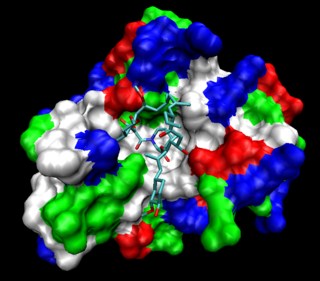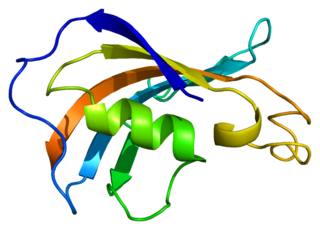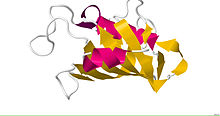
Spermatogenesis is the process by which haploid spermatozoa develop from germ cells in the seminiferous tubules of the testis. This process starts with the mitotic division of the stem cells located close to the basement membrane of the tubules. These cells are called spermatogonial stem cells. The mitotic division of these produces two types of cells. Type A cells replenish the stem cells, and type B cells differentiate into primary spermatocytes. The primary spermatocyte divides meiotically into two secondary spermatocytes; each secondary spermatocyte divides into two equal haploid spermatids by Meiosis II. The spermatids are transformed into spermatozoa (sperm) by the process of spermiogenesis. These develop into mature spermatozoa, also known as sperm cells. Thus, the primary spermatocyte gives rise to two cells, the secondary spermatocytes, and the two secondary spermatocytes by their subdivision produce four spermatozoa and four haploid cells.
Azoospermia factor (AZF) is one of several proteins or their genes, which are coded from the AZF region on the human male Y chromosome. Deletions in this region are associated with inability to produce sperm. Subregions within the AZF region are AZFa, AZFb and AZFc. AZF microdeletions are one of the major causes of male infertility for azoospermia and severe oligozoospermia males. AZF is the term used by the HUGO Gene Nomenclature Committee.

The FKBPs, or FK506 binding proteins, constitute a family of proteins that have prolyl isomerase activity and are related to the cyclophilins in function, though not in amino acid sequence. FKBPs have been identified in many eukaryotes, ranging from yeast to humans, and function as protein folding chaperones for proteins containing proline residues. Along with cyclophilin, FKBPs belong to the immunophilin family.

FK506-binding protein 4 is a protein that in humans is encoded by the FKBP4 gene.

Peptidyl-prolyl cis-trans isomerase FKBP1A is an enzyme that in humans is encoded by the FKBP1A gene. It is also commonly referred to as FKBP-12 or FKBP12 and is a member of a family of FK506-binding proteins (FKBPs).

Deleted in azoospermia-like is a protein that in humans is encoded by the DAZL gene.

Deleted in azoospermia 1, also known as DAZ1, is a protein which in humans is encoded by the DAZ1 gene.

FK506 binding protein 5, also known as FKBP5, is a protein which in humans is encoded by the FKBP5 gene.

FK506-binding protein 8 is a protein that in humans is encoded by the FKBP8 gene.

Peptidyl-prolyl cis-trans isomerase FKBP1B is an enzyme that in humans is encoded by the FKBP1B gene.

FK506-binding protein 3 also known as FKBP25 is a protein that in humans is encoded by the FKBP3 gene.

Glomulin is a protein that in humans is encoded by the GLMN gene.

FK506-binding protein 2 is a protein that in humans is encoded by the FKBP2 gene.

Synaptonemal complex protein 3 is a protein that in humans is encoded by the SYCP3 gene. It is a component of the synaptonemal complex formed between homologous chromosomes during the prophase of meiosis.

FK506-binding protein 10 is a protein that in humans is encoded by the FKBP10 gene.

FK506-binding protein 9 is a protein that in humans is encoded by the FKBP9 gene.

Mild androgen insensitivity syndrome (MAIS) is a condition that results in a mild impairment of the cell's ability to respond to androgens. The degree of impairment is sufficient to impair spermatogenesis and / or the development of secondary sexual characteristics at puberty in males, but does not affect genital differentiation or development. Female genital and sexual development is not significantly affected by the insensitivity to androgens; as such, MAIS is only diagnosed in males. The clinical phenotype associated with MAIS is a normal male habitus with mild spermatogenic defect and / or reduced secondary terminal hair.
FK506 binding protein 7 is a protein that in humans is encoded by the FKBP7 gene. The gene is also known as FKBP23 and PPIase. FKBP7 belongs to the FKBP-type peptidyl-prolyl cis/trans isomerase (PPIase) family. Members of this family exhibit PPIase activity and function as molecular chaperones. The orthologous protein in mouse is located in the endoplasmic reticulum and binds calcium.

Stromal antigen 3 is a protein that in humans is encoded by the STAG3 gene. STAG3 protein is a component of a cohesin complex that regulates the separation of sister chromatids specifically during meiosis. STAG3 appears to be paramount in sister-chromatid cohesion throughout the meiotic process in human oocytes and spermatocytes.

Testis expressed 15 is a protein that in humans is encoded by the TEX15 gene.

















